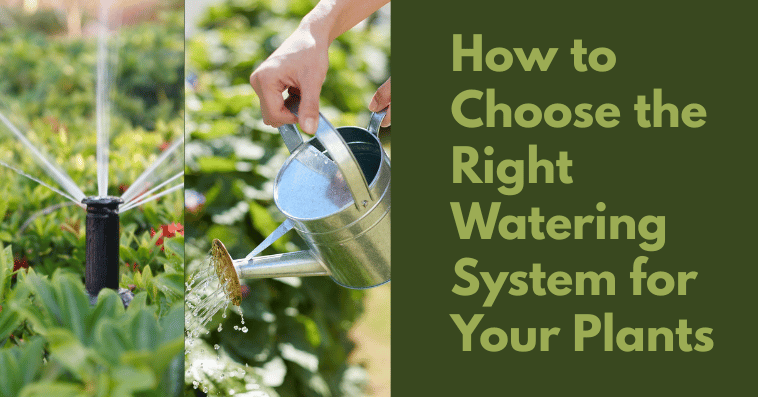Watering your plants sounds simple, right? Just grab a can and pour. But any seasoned gardener knows that improper watering is one of the most common reasons for wilting, yellowing, root rot, and stunted growth. Whether you’re growing a balcony herb garden, indoor foliage, or a full-scale backyard setup, choosing the right watering system for your plants can make or break your gardening success.
In this guide, we’ll explore various types of plant watering systems, the pros and cons of each, and help you find the one that suits your plant type, garden size, lifestyle, and climate.
Why the Right Watering System Matters
A good watering system ensures your plants get the right amount of water at the right time, without wastage. It saves you time, effort, and water — especially if you have a busy lifestyle, travel frequently, or manage a large garden.
The right system can:
Improve plant health and yield
Prevent overwatering and underwatering
Reduce manual labor
Conserve water
Automate regular care
Let’s dive into the options so you can pick the best watering system for your plants.
1. Manual Watering: Traditional but Time-Intensive
Best For:
Small indoor plants
Balcony gardens
Houseplants
Manual watering using a watering can or hose is ideal if you only have a handful of plants and enjoy the hands-on care. You can control the flow, direction, and amount—but it’s not the best for forgetful or busy gardeners.
Pros:
✅ Low cost
✅ Easy to start
✅ Full control over watering
Cons:
❌ Time-consuming
❌ Inconsistent if done in a rush
❌ Doesn’t scale well for larger gardens
2. Drip Irrigation System: Precision Watering for Larger Gardens
Best For:
Outdoor vegetable gardens
Flower beds
Raised planters
Drip irrigation delivers water directly to plant roots through a network of tubes, emitters, and valves. It’s extremely efficient and reduces water evaporation and runoff.
Pros:
✅ Water-efficient
✅ Reduces weed growth
✅ Suitable for automation with timers
Cons:
❌ Higher setup cost
❌ Tubes can clog if not maintained
❌ Not ideal for potted indoor plants
3. Soaker Hoses: Easy & Even Distribution
Best For:
Garden beds
Shrubbery lines
Flower borders
Soaker hoses are porous hoses that release water slowly along their length, allowing water to seep directly into the soil.
Pros:
✅ Even watering
✅ Conserves water
✅ Can be buried under mulch
Cons:
❌ Not precise for individual plants
❌ Less control over water output
❌ May deteriorate over time
4. Self-Watering Pots: The Smart Indoor Solution
Best For:
Indoor plants
Office plants
Busy or traveling gardeners
Self-watering pots come with a built-in reservoir at the base. The plant draws water through a wick or soil as needed, reducing the risk of over or under-watering.
Pros:
✅ Low-maintenance
✅ Perfect for forgetful plant parents
✅ Prevents soggy soil
Cons:
❌ Slightly expensive
❌ Not suitable for large outdoor plants
❌ Must refill the reservoir periodically
5. Automatic Sprinkler Systems: Ideal for Lawns & Landscapes
Best For:
Lawns
Large gardens
Commercial spaces
Sprinklers can cover large areas and be set on timers or smart irrigation controllers. There are pop-up, oscillating, and rotary sprinklers depending on the coverage needed.
Pros:
✅ Fully automated
✅ Great for grass and groundcover
✅ Can be connected to rain sensors
Cons:
❌ Water waste if not calibrated properly
❌ Can’t target specific plants
❌ Requires professional setup
6. Plant Watering Spikes & Globes: Good for Vacations
Best For:
Short-term travel
Small to medium houseplants
These tools slowly release water into the soil over several days. They’re perfect if you’re going on vacation or want to supplement between regular waterings.
Pros:
✅ Easy to install
✅ Affordable
✅ Good for short-term hydration
Cons:
❌ Limited capacity
❌ Can clog
❌ Not suitable for high-water-demand plants
How to Choose the Right Watering System: 5 Quick Tips
Still confused? Here’s how to choose the best watering system for your plants:
✅ 1. Assess Plant Type and Quantity
Succulents need less water than tropical plants. Large gardens require different systems than indoor pots.
✅ 2. Understand Your Schedule
If you're a frequent traveler or busy professional, opt for self-watering or automated systems.
✅ 3. Consider the Climate
In dry or hot regions, drip or soaker systems reduce evaporation. In humid climates, use breathable systems to avoid overwatering.
✅ 4. Think About Water Conservation
If water bills or sustainability matter to you, go for efficient options like drip irrigation or self-watering planters.
✅ 5. Check Your Budget
Manual watering is cheapest, but automated systems save time and effort in the long run.
Bonus: Combine Systems for Best Results
You don’t have to stick to just one system. Use:
Drip irrigation for your garden bed
Self-watering pots for indoor herbs
Watering spikes for short holidays
Smart combinations = maximum efficiency and plant health!
Final Thoughts: Your Plants Deserve the Best
Choosing the right watering system for your plants can be the difference between a thriving garden and a struggling one. The right system doesn’t just save water—it saves your time, energy, and worry.
From lush lawns and ornamental beds to potted balconies and cozy indoor corners, there’s a watering solution for every plant and lifestyle. Make an informed choice today and watch your garden bloom with joy.
Shop Smart Watering Solutions at PaudheWale!
Looking to upgrade your watering game? Find drip irrigation kits, self-watering pots, watering cans, spikes, and more—all curated for gardeners at every level — only at PaudheWale.
With top-quality tools, timely delivery, and sustainable choices, PaudheWale makes gardening easier and greener.
🌿 Visit now and help your plants thrive with the perfect watering system!

